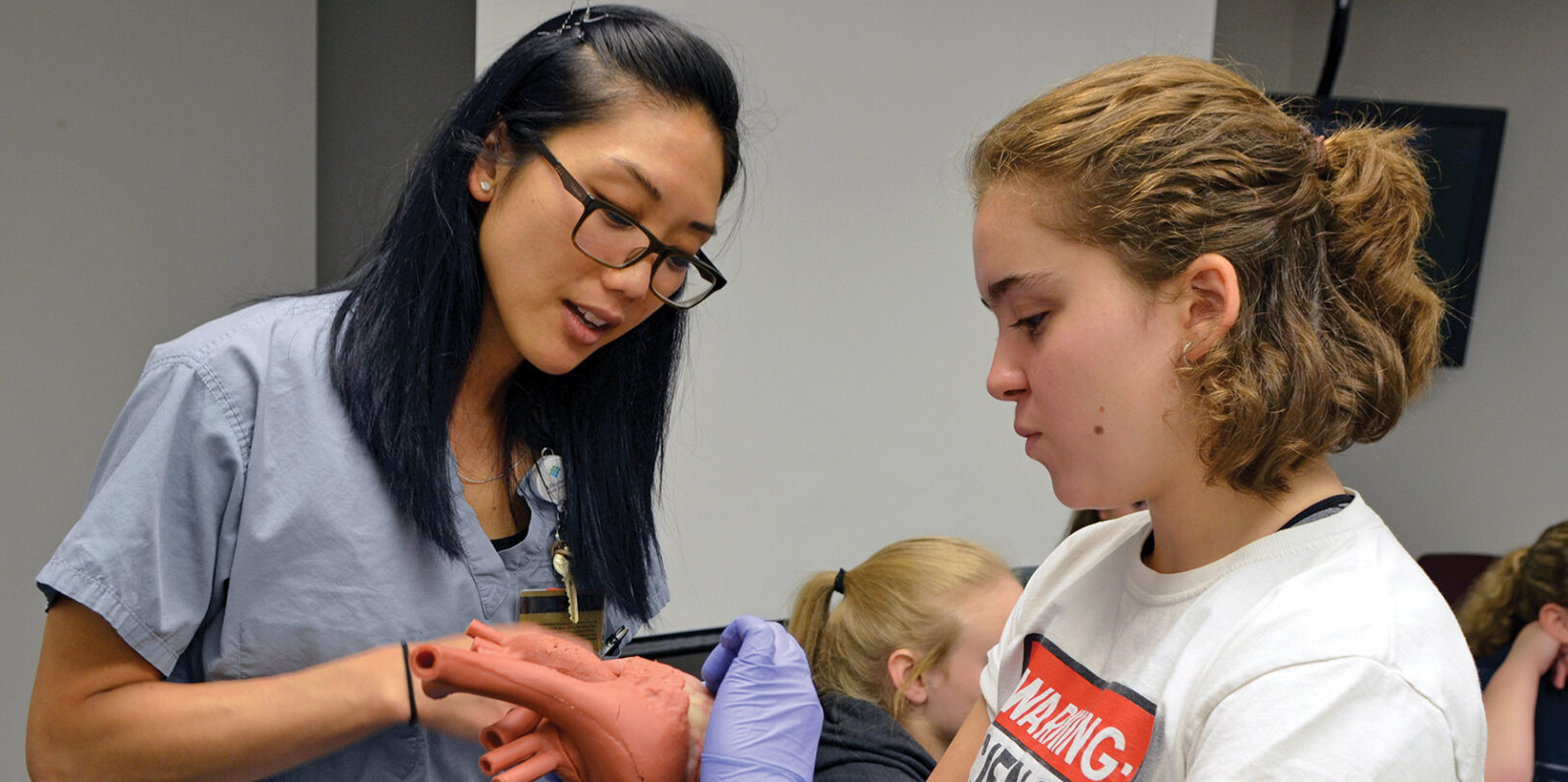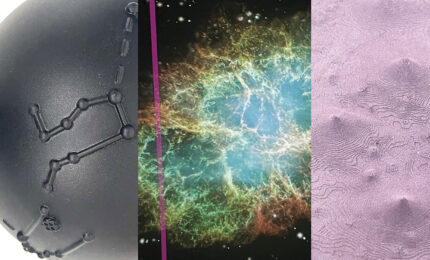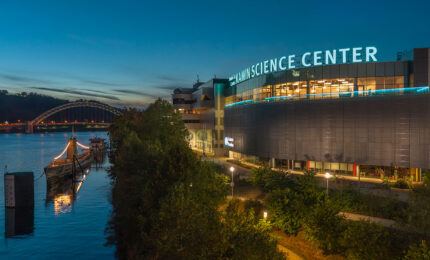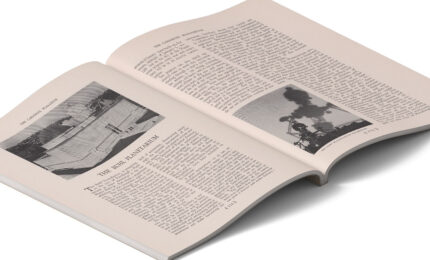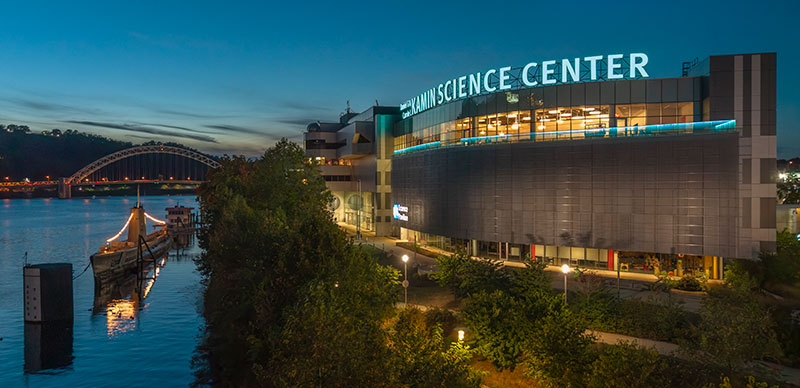Twelve-year-old Anastasia Davis beams as she strokes the back feathers of a penguin at the Pittsburgh Zoo & PPG Aquarium. But she isn’t at the Highland Park attraction for a cute photo-op with the tuxedoed bird with a yellow crown of feathers. The 12-year-old is among a small group of girls listening as a female scientist describes the mating behavior of macaroni penguins.
While Davis is passionate about zoology —she even talks about working at a wildlife refuge—the sixth-grader from Ohio Township is curious about all sorts of scientific fields. She’s a regular at Tour Your Future, Carnegie Science Center’s career exploration program that gives girls in middle and high school the chance to meet female professionals who work in science, technology, engineering, and math (STEM) fields. The Science Center partners with corporations and nonprofits to showcase fields ranging from avian zoology to software engineering, medicine, and accounting.
Davis, a student at Blessed Francis Seelos Academy in Wexford, is the type of insatiably curious kid who always has a great question—and she finds it refreshing to pose her queries to female scientists. “Most of the time when you see representatives of science jobs, they’re men,” says Davis. “You don’t really see that many women in science careers.”
To help shrink the gender gap, the Science Center organizes a series of tours at various job sites each fall and spring led by women in those fields. Tours are open to girls ages 11 to 17 and cost $5 per site visit. Individuals and groups are welcome.
“The girls talk to female professionals about how they got to their current jobs, what courses they took in high school and college, and what they do at work every day,” says Tina Seidelson, program manager for Carnegie STEM Girls, a project of the Science Center’s Chevron Center for STEM Education and Career Development. “It exposes them to the many different career fields available in STEM.” Each two-hour visit includes a hands-on activity.
For example, Davis is one of 11 girls who on this January day is visiting Eaton Corporation’s Power Systems Experience Center in Warrendale to learn about electricity, the invisible energy source that keeps the lights on, smartphones charged, and modern life humming along.
“It was so cool. I love the hands-on experience. I learn better that way.”
– Maansi Shah, a freshman at Thomas Jefferson High school
Ellen Bachman, a senior engineer, explains the distribution of power in a house and how circuit breakers offer protection. The girls don safety glasses and practice wiring their own circuits as Bachman gives instructions and encouragement. “Stick that wire in there and don’t worry about breaking it. You won’t,” she says.
Following the activity, Bachman fields questions. She talks about starting at the University of Pittsburgh (Pitt) as a math major until she began talking to a friend, who was an engineer, and thought, “That looks like way more fun.” She received both a bachelor’s and master’s degree in electrical engineering from Pitt and never looked back.
Allison Artz and Valerie Vondrak, both members of the Finance Leadership Development Program at Eaton, talk to the group about their careers in finance. “It’s awesome because of the math,” Vondrak tells the girls. Artz confides that she loves her career because she gets to work with spreadsheets, which triggers several comments from the young audience members about their experience with Microsoft Excel.
Anastasia Davis attended most of last year’s Tour Your Future visits, and the zoo wasn’t the only experience that stood out. She especially liked the botany-focused tour at Phipps Conservatory and her visit to BoXZY, a company that builds robots for 3D printing and laser engraving. In addition to talking to the women who create, test, and program the robots, the girls were given the chance to do their own laser engraving.
Sandhya Rao, an astronomer at Pitt, shares with participants her love of the science of the universe during their visits to the Allegheny Observatory. As a professor of astronomy, part of the male-dominated field of physics, she finds an instant connection with the girls, who ask her questions about everything from the big bang theory to black holes and stars.
At the observatory, the girls put on diffraction grating glasses, which separate light into various colors. Looking at different elemental gases, through the lenses, they can see the unique patterns. “Each element has its own fingerprint,” Rao says. “It shows the girls what an astronomer actually does.”
Rao is always amazed at how much astronomy the girls have learned on their own. “They ask me a question, and I am flabbergasted about how much they know. They are so curious. Curiosity is everything.”
She encourages the students to email or call her if they have more questions after their day at the observatory. “Even if you reach one girl, it’s worth it. I think Tour Your Future is really great for young girls.”
Maansi Shah, a freshman at Thomas Jefferson High School, enjoyed her visit to the forensic lab at Duquesne University. The program focused on the evidence left at crime scenes and how investigators dust for fingerprints. As an activity, Shah got to try it out for herself—she placed her palm on a piece of paper and then covered it with a powder that picked up on the residue left by her hands. “It was so cool,” she says. “I love the hands-on experience. I learn better that way.”
The 15-year-old sees the value in a science career program that is female focused. “There are not enough women in science-related programs or engineering,” says Shah. “This shows you that women can do the same thing as men can.”
Tour Your Future also ventures into hospitals, creating opportunities for girls to connect with surgeons, biomedical engineers, and other
medical professionals.
At Magee-Womens Hospital of UPMC, Ann Kozak, 15, bends over her patient—a cloth dummy. Following the instruction of a female doctor, Kozak sutures an incision in the cloth “skin” with about 10 stitches before tying the surgical thread in a knot.
“It was really an amazing experience—just like a real surgeon,” says Kozak, a 10th-grader at Trinity High School in Washington, Pa. “It was so cool.”
Besides the suturing experience, physician Charelle Carter-Brooks discussed the anatomical components of the female reproductive system and had the visitors assemble 3D models of the pelvis. “It was cool to see how these organs fit together, because we can’t see them in our bodies,” Kozak says.
She really likes science, but she knows that some girls may shy away from STEM because they are intimidated. “This program lets girls realize they can do it,” Kozak says. “It showed me I can do it.”
Tour Your Future, presented by Valspar, is a program of Carnegie STEM Girls, presented by NOVA Chemicals.
